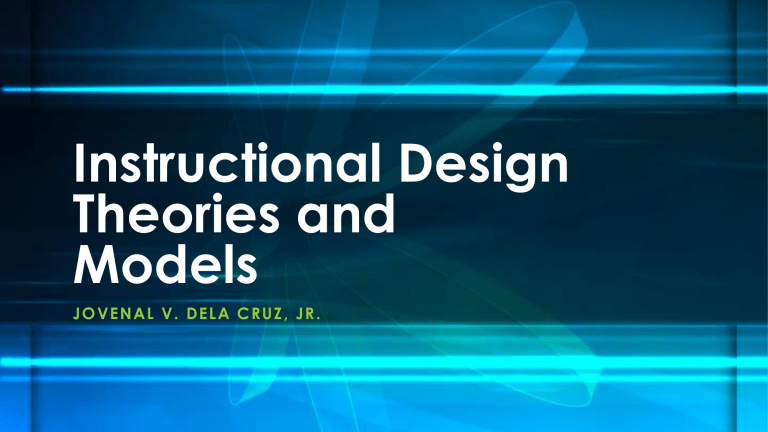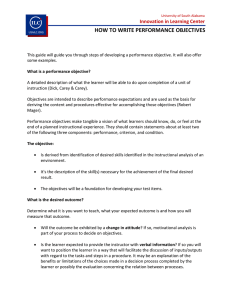
Instructional Design Theories and Models J OV E NAL V . D E LA CR U Z , J R . What is instructional design? • The systematic and reflective process of translating principles of learning and instruction and instruction into plans for instructional materials, activities, information resources and evaluation (Smith and Ragan, 1999). • “The theory and practice of design, development, utilization, management, and evaluation of processes and resources for learning” (Association for Educational Communications and Technology (AECT) as cited by Resier, 2002 and Serhat Kurt) https://www.edsurge.com/news/2015-10-07-so-what-do-you-reallymean-by-instructional-designer Bloom’s Taxonomy of Learning https://www.thoughtco.com/blooms-taxonomyapplication-category-8445 Origination: Creating new movement patterns to fit a particular situation or specific problem. Learning outcomes emphasize creativity based upon highly developed skills. (creates, designs, initiate, makes, originates) Adaptation: Skills are well developed and the individual can modify movement patterns to fit special requirements. Complex Overt Response (Expert): The skilful performance of motor acts that involve complex movement patterns. Proficiency is indicated by a quick, accurate, and highly coordinated performance, requiring a minimum of energy. (measures, mends, mixes, organizes) Mechanism (basic proficiency): Learned responses have become habitual and the movements can be performed with some confidence and proficiency. (assembles, builds, calibrates, constructs) Guided Response: The early stages in learning a complex skill that includes imitation and trial and error. Adequacy of performance is achieved by practicing. (copies, traces, follows, react) Set: Readiness to act. It includes mental, physical, and emotional sets. These three sets are dispositions that predetermine a person's response to different situations (sometimes called mindsets). ( begins, displays, explains, moves) Perception (awareness): The ability to use sensory cues to guide motor activity. This ranges from sensory stimulation, through cue selection, to translation. (chooses, describes, detects) http://www.nwlink.com/~donclark/hrd/Bloom/psychomotor_dom .html FOUNDATIONAL LEARNING THEORY OF ID Behaviorism Cognitivism Constructivism What is the difference between ___ ? Theory a plausible or scientifically acceptable general principle or body of principles offered to explain phenomena; a belief, policy, or procedure proposed or followed as the basis of action (Merriam Webster); explain the application, interpretation and purpose of learning and education, pedagogical, instructional and learning theory which explore how we best learn so that those who teach can apply corresponding research findings to applied practice Model a set of plans; structural design or representation of something (Merriam Webster); views of pedagogical theories or approaches that are used to guide the specialists and teachers in the elaboration and analysis of studies programs, in the systematization of the teachinglearning process, or rather in the comprehension of some part of a studies program (UNIBE) Cognitive Information Processing Theory Encoding Organization Mnemonics Imagery Encoding Recognition Recall Selective Attention Meaning Similarity of Tasks Complexity/Difficulty Attention ability Chunking Rehearsal Maintenance Rehearsal Elaborative Rehearsal Encoding specificity principle states that whatever cues are used by a learner to facilitate encoding will also serve as the best retrieval cues at test time. For learning and instruction to be meaningful and relevant, it must build upon the learner's prior knowledge and help the learner to make connections between what they already know and what they are about to learn. “Different types of learning exist, and that different instructional conditions are most likely to bring about these different types of learning.” Gagne’s Theory of Instruction Internal External Reception Preparation Expectancy Retrieval Presentation Semantic Encoding Selective Perception Responding Performance Reinforcement Validation Generalization Retrieval Principles • 1. Different instruction is required for different learning outcomes. • 2. Events of learning operate on the learner in ways that constitute the conditions of learning. • 3. The specific operations that constitute instructional events are different for each different type of learning outcome. • 4. Learning hierarchies define what intellectual skills are to be learned and a sequence of instruction. Gagné’s Nine Events of Instruction Reigeluth’s Elaboration Theory ELABORATION THEORY Sequence Organize Summarization Procedural Conceptual Elaboration Sequencing Theoretical Elaboration Sequencing Simplifying Condition Method Heuristics Synthesize Analogy Specific to Complex Cognitive-Strategy Activator Learner Control instruction should be organized in increasing order of complexity for optimal learning First Principle of Instruction Theory (David Merrill) “truly effective learning experiences are rooted in problem-solving” Integration Learning is promoted when learners are engaged in solving real-world problems Learning is promoted when existing knowledge is activated as a foundation for new knowledge Learning is promoted when new knowledge is demonstrated to the learner Learning is promoted when new knowledge is applied by the learner Learning is promoted when new knowledge is integrated into the learner’s world Activation Where do I start? (Watch me! Task/Problem (Let me do it! Let me do the whole task! Application Don’t just tell me, show me! Demostration COMPONENT DISPLAY THEORY Principles 1. Instruction will be more effective if all three primary performance forms (remember, use, generality) are present. 2. Primary forms can be presented by either an explanatory or inquisitory learning strategy 3. The sequence of primary forms is not critical provided they are all present. 4. Students should be given control over the number of instances or practice items they receive. LEARNING CONTENT PERFORMANCE facts, concepts, procedures, and principles remembering, using, finding Mode of Presentation Primary Secondary Rules Examples Recall Practice Prerequisites Objectives Helps Mnemonics Feedback CDT Content-Performance Matrix Component Fact Concept Procedure Principle Remember(ing) Remember the characteristi cs Remember the definition Remember the stages/steps Remember the guidelines Use(ing) Use the characteristi cs Use the definition Use/apply the stages/steps Use the guidelines Find(ing) Find the characteristi cs Find/state the definition Look/evaluate Find/explain the the stages/steps guidelines ARCS MODEL It is important to motivate the learners, and ensure the continuity of the motivation during the instruction. ATTENTION Perceptual Arousal Inquiry Arousal Variability SATISFACTION Intrinsic Reinforcement Extrinsic Reward Equity MOTIVATION IN THE LEARNING PROCESS CONFIDENCE Learning Requirements Success Opportunities Personal Contro RELEVANCE Goal Orientation Motive Matching Familiarity Situation Learning Theory • every human thought is adapted to the environment, that is, situated, because what people perceive, how they conceive of their activity, and what they physically do develop together Situated Learning Knowledge Presentation in Authentic Context Legitimate Peripheral Participation Activity Culture Context Application Community of Practice Beliefs and Behavior (Social Interaction and Collaboration Sociocultural Theory Children are entrenched in different sociocultural contexts and their cognitive development is advanced through social interaction with more skilled individuals. Cognitive Development Culture “through others we become ourselves” Society community plays a central role in the process of "making meaning” Learning precedes development Learner Social Interaction MKO Don’t Know Language ZPD Learner You Do Know Do know Scaffolding Learning is to construct knowledge individually and/or socially based on learners’ interpretations of experiences in the world. Knowledge Construction Educational Technologies Context D. H. Jonassen’s Instructional Design Theory (Associate Learning Theory ) Instructional Activities Modelling Coaching Related Cases Cognitive Tools Information Resources Conversation/ Collaboration Tools Scaffolding Representation Problem Manipulation Methods Social/Contextual Support Constructivist Learning Environments (CLEs) A constructivist design process should be concerned with designing environments which support the construction of knowledge (Meaning making). ADDIE MODEL ANALYSIS A FORMATIVE SUMMATIVE EVALUATE IMPLEMENT I EVALUATE E EVALUATE VALIDITY FUNCTIONALITY USABILITY REPLICABILITY NEEDS TASKS PERFORMANCE GOALS GAPS D DEVELOP EVALUATE D DESIGN COMPETENCIES OBJECTIVE DELIVERY FORMAT ACTIVITIES/EXERCISES BLUEPRINT CREATION OF THE MATERIAL PILOT TESTING BUILD SUCCESSIVE APROXIMATION MODEL (SAM 1) Situation Success Need Success Needs Goals Effectiveness improvement Gaps START Further Revision Prepare/Make of the prototype Revise the the Prototype Production of prototype Implement more copies EVALUATE DEVELOP END DESIGN ITERATION III Sketch new alternatives Revise or Refine pervious Refine ideas Successive Approximation Model (SAM 2) Prototype Information Gathering Preparation Phase Design Savvy Start Project Planning Iterative Design Phase Review Develop Additional Design Design Proof Evaluate Alpha Iterative Development Phase Beta ROLLOUT Background Implement Gold DICK AND CAREY MODEL Conduct Instructional Analysis Conduct Instructional Analysis Identify Instructional Goal Write Performance Objectives Identify Entry Behaviors Develop Criterion Referenced Tests Develop Instruction Strategy Develop and Select Instructional Materials Develop and Conduct Formative Evaluation Develop and Conduct Summative Evaluation ASSURE MODEL ANALYSE LEARNERS What works? What doesn’t? How do teachers ensure participation? EVALUATE AND REVISE REQUIRE LEARNER PARTICIPATION Who is the learner? A S E STATE OBJECTIVES ASSURE MODEL R S U UTILIZE MEDIA, MATERIALS SELECT METHODS, MEDIA, MATERIALS How do teachers use the materials? What do students need to learn? What do teachers need to use for teaching? Hannafin & Peck Model Learner’s characteristics Prior Knowledge Objectives Desired Behavior Change Learning Gaps PHASE 1. NEEDS ASSESSMENT Objectives Content Activities Materials needed Methods Shape and Structure, Learning theories Media and technology PHASE 2. DESIGN Production Implementation PHASE 3. DEVELOP/IMPLEMENT START EVALUATION AND REVISION References • Dick and Carey Model. Retrieved from http://www.instructionaldesign.org/models/dick_carey_model/ • The Dick and Carey Model – 1978. Retrieved from http://www.nwlink.com/~donclark/history_isd/carey.html • Pappas, C. (2015). 9 Steps To Apply The Dick And Carey Model In eLearning. Retrieved from https://elearningindustry.com/9-steps-to-apply-the-dick-and-carey-model-in-elearning • Systems Approach Model for Designing Instruction (Dick & Carey). Novita Training. 1-773-590-3636 info@novitaunique.com www.novitatraining.com • Dick, W. (2012). The Dick and Carey Model: Will It Survive the Decade?. Educational Technology Research and Development, Vol. 44, No. 3 (1996), pp. 55-63. Springer Stable. http://www.jstor.org/stable/30221035 . • Isman, A., Caglar, M., Dabaj, F., Ersozlu, H. (2005). A NEW MODEL FOR THE WORLD OF INSTRUCTIONAL DESIGN: A NEW MODEL. The Turkish Online Journal of Educational Technology – TOJET July 2005 ISSN: 13036521 volume 4 Issue 3 Article 6 • Pappas, C. (2016)Applying The Hannafin-Peck Model In eLearning . https://www.efrontlearning.com/blog/2016/03/applying-the-hannafin-peck-model-in-elearning.html


